Chengpeng Hu
3D Building Generation in Minecraft via Large Language Models
Jun 13, 2024



Abstract:Recently, procedural content generation has exhibited considerable advancements in the domain of 2D game level generation such as Super Mario Bros. and Sokoban through large language models (LLMs). To further validate the capabilities of LLMs, this paper explores how LLMs contribute to the generation of 3D buildings in a sandbox game, Minecraft. We propose a Text to Building in Minecraft (T2BM) model, which involves refining prompts, decoding interlayer representation and repairing. Facade, indoor scene and functional blocks like doors are supported in the generation. Experiments are conducted to evaluate the completeness and satisfaction of buildings generated via LLMs. It shows that LLMs hold significant potential for 3D building generation. Given appropriate prompts, LLMs can generate correct buildings in Minecraft with complete structures and incorporate specific building blocks such as windows and beds, meeting the specified requirements of human users.
Generating Games via LLMs: An Investigation with Video Game Description Language
Apr 11, 2024



Abstract:Recently, the emergence of large language models (LLMs) has unlocked new opportunities for procedural content generation. However, recent attempts mainly focus on level generation for specific games with defined game rules such as Super Mario Bros. and Zelda. This paper investigates the game generation via LLMs. Based on video game description language, this paper proposes an LLM-based framework to generate game rules and levels simultaneously. Experiments demonstrate how the framework works with prompts considering different combinations of context. Our findings extend the current applications of LLMs and offer new insights for generating new games in the area of procedural content generation.
Pre-trained Universal Medical Image Transformer
Dec 12, 2023Abstract:Self-supervised learning has emerged as a viable method to leverage the abundance of unlabeled medical imaging data, addressing the challenge of labeled data scarcity in medical image analysis. In particular, masked image modeling (MIM) with visual token reconstruction has shown promising results in the general computer vision (CV) domain and serves as a candidate for medical image analysis. However, the presence of heterogeneous 2D and 3D medical images often limits the volume and diversity of training data that can be effectively used for a single model structure. In this work, we propose a spatially adaptive convolution (SAC) module, which adaptively adjusts convolution parameters based on the voxel spacing of the input images. Employing this SAC module, we build a universal visual tokenizer and a universal Vision Transformer (ViT) capable of effectively processing a wide range of medical images with various imaging modalities and spatial properties. Moreover, in order to enhance the robustness of the visual tokenizer's reconstruction objective for MIM, we suggest to generalize the discrete token output of the visual tokenizer to a probabilistic soft token. We show that the generalized soft token representation can be effectively integrated with the prior distribution regularization through a constructive interpretation. As a result, we pre-train a universal visual tokenizer followed by a universal ViT via visual token reconstruction on 55 public medical image datasets, comprising over 9 million 2D slices (including over 48,000 3D images). This represents the largest, most comprehensive, and diverse dataset for pre-training 3D medical image models to our knowledge. Experimental results on downstream medical image classification and segmentation tasks demonstrate the superior performance of our model and improved label efficiency.
Generating Redstone Style Cities in Minecraft
Jul 19, 2023Abstract:Procedurally generating cities in Minecraft provides players more diverse scenarios and could help understand and improve the design of cities in other digital worlds and the real world. This paper presents a city generator that was submitted as an entry to the 2023 Edition of Minecraft Settlement Generation Competition for Minecraft. The generation procedure is composed of six main steps, namely vegetation clearing, terrain reshaping, building layout generation, route planning, streetlight placement, and wall construction. Three algorithms, including a heuristic-based algorithm, an evolving layout algorithm, and a random one are applied to generate the building layout, thus determining where to place different redstone style buildings, and tested by generating cities on random maps in limited time. Experimental results show that the heuristic-based algorithm is capable of finding an acceptable building layout faster for flat maps, while the evolving layout algorithm performs better in evolving layout for rugged maps. A user study is conducted to compare our generator with outstanding entries of the competition's 2022 edition using the competition's evaluation criteria and shows that our generator performs well in the adaptation and functionality criteria
Constrained Reinforcement Learning for Dynamic Material Handling
May 23, 2023
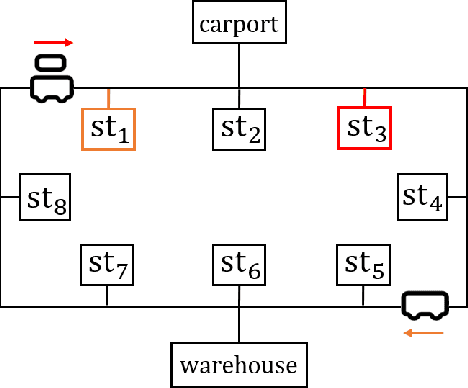


Abstract:As one of the core parts of flexible manufacturing systems, material handling involves storage and transportation of materials between workstations with automated vehicles. The improvement in material handling can impulse the overall efficiency of the manufacturing system. However, the occurrence of dynamic events during the optimisation of task arrangements poses a challenge that requires adaptability and effectiveness. In this paper, we aim at the scheduling of automated guided vehicles for dynamic material handling. Motivated by some real-world scenarios, unknown new tasks and unexpected vehicle breakdowns are regarded as dynamic events in our problem. We formulate the problem as a constrained Markov decision process which takes into account tardiness and available vehicles as cumulative and instantaneous constraints, respectively. An adaptive constrained reinforcement learning algorithm that combines Lagrangian relaxation and invalid action masking, named RCPOM, is proposed to address the problem with two hybrid constraints. Moreover, a gym-like dynamic material handling simulator, named DMH-GYM, is developed and equipped with diverse problem instances, which can be used as benchmarks for dynamic material handling. Experimental results on the problem instances demonstrate the outstanding performance of our proposed approach compared with eight state-of-the-art constrained and non-constrained reinforcement learning algorithms, and widely used dispatching rules for material handling.
Game-based Platforms for Artificial Intelligence Research
Apr 26, 2023Abstract:Games have been the perfect test-beds for artificial intelligence research for the characteristics that widely exist in real-world scenarios. Learning and optimisation, decision making in dynamic and uncertain environments, game theory, planning and scheduling, design and education are common research areas shared between games and real-world problems. Numerous open-sourced games or game-based environments have been implemented for studying artificial intelligence. In addition to single- or multi-player, collaborative or adversarial games, there has also been growing interest in implementing platforms for creative design in recent years. Those platforms provide ideal benchmarks for exploring and comparing artificial intelligence ideas and techniques. This paper reviews the game-based platforms for artificial intelligence research, discusses the research trend induced by the evolution of those platforms, and gives an outlook.
Evolving Constrained Reinforcement Learning Policy
Apr 19, 2023Abstract:Evolutionary algorithms have been used to evolve a population of actors to generate diverse experiences for training reinforcement learning agents, which helps to tackle the temporal credit assignment problem and improves the exploration efficiency. However, when adapting this approach to address constrained problems, balancing the trade-off between the reward and constraint violation is hard. In this paper, we propose a novel evolutionary constrained reinforcement learning (ECRL) algorithm, which adaptively balances the reward and constraint violation with stochastic ranking, and at the same time, restricts the policy's behaviour by maintaining a set of Lagrange relaxation coefficients with a constraint buffer. Extensive experiments on robotic control benchmarks show that our ECRL achieves outstanding performance compared to state-of-the-art algorithms. Ablation analysis shows the benefits of introducing stochastic ranking and constraint buffer.
Robust Reinforcement Learning for General Video Game Playing
Nov 11, 2020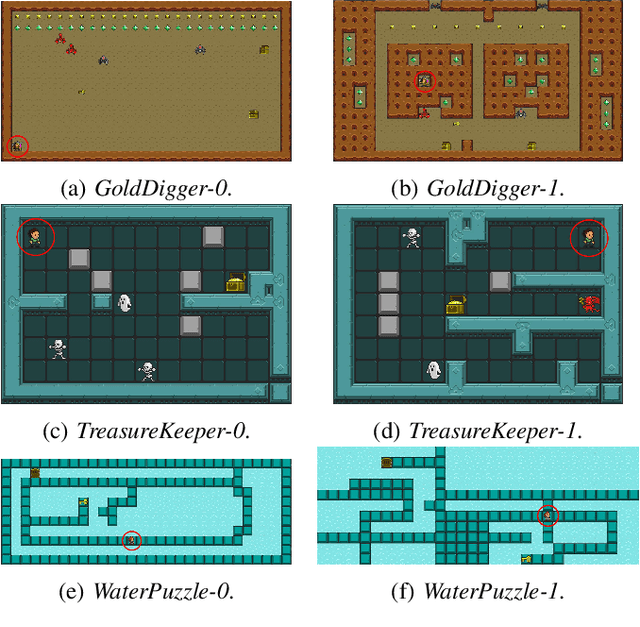
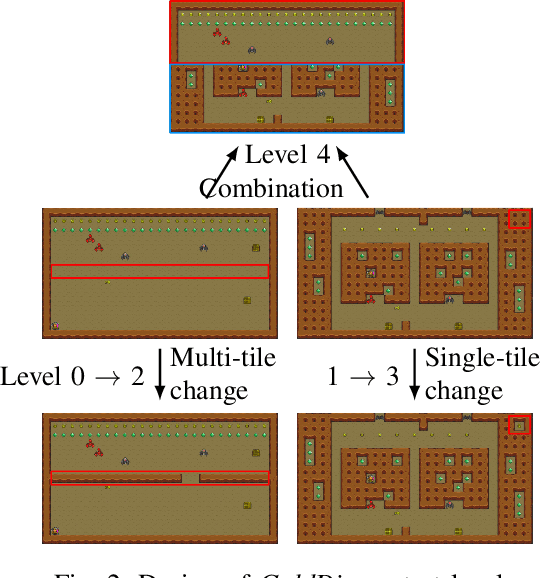
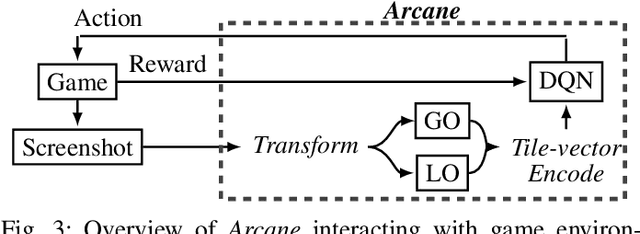
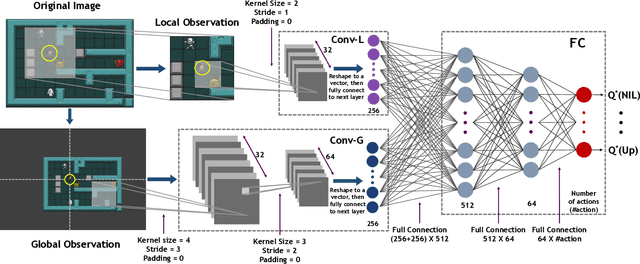
Abstract:Reinforcement learning has successfully learned to play challenging board and video games. However, its generalization ability remains under-explored. The General Video Game AI Learning Competition aims at designing agents that are capable of learning to play different games levels that were unseen during training. This paper presents the games, entries and results of the 2020 General Video Game AI Learning Competition, held at the Sixteenth International Conference on Parallel Problem Solving from Nature and the 2020 IEEE Conference on Games. Three new games with sparse, periodic and dense rewards, respectively, were designed for this competition and the test levels were generated by adding minor perturbations to training levels or combining training levels. In this paper, we also design a reinforcement learning agent, called Arcane, for general video game playing. We assume that it is more likely to observe similar local information in different levels rather than global information. Therefore, instead of directly inputting a single, raw pixel-based screenshot of current game screen, Arcane takes the encoded, transformed global and local observations of the game screen as two simultaneous inputs, aiming at learning local information for playing new levels. Two versions of Arcane, using a stochastic or deterministic policy for decision-making during test, both show robust performance on the game set of the 2020 General Video Game AI Learning Competition.
 Add to Chrome
Add to Chrome Add to Firefox
Add to Firefox Add to Edge
Add to Edge